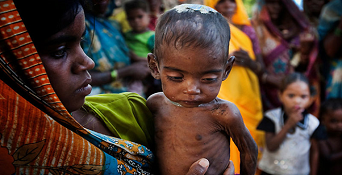India needs to scale up direct nutrition interventions
Context
More than seven decades after independence, India still suffers from the public health issues such as child malnutrition attributing to 68.2% of under-five child mortality.
- Data from the National Family Health Survey (NFHS)-5 2019-21, as compared to NFHS-4 2015-16, reveals a substantial improvement in the period of four to five years in several proxy indicators of women’s empowerment.

What is malnutrition?
- Malnutrition refers to deficiencies, excesses or imbalances in a person’s intake of energy and/or nutrients.
- The term malnutrition covers 2 broad groups of conditions.
|
Undernutrition |
Overweight |
|
|
NFHS-4 v/s NFHS-5
- As per the NFHS-5 2019-21, India has substantially improved in various indicators of women’s empowerment as compared to the NFHS-4 2015-16. The substantial improvements are:
- Antenatal service attendance (58.6 to 70.0%)
- women having their own saving bank accounts (63.0 to78.6%)
- women owning mobile phones that they themselves use (45.9 % to 54.0%)
- women married before 18 years of age (26.8 % to 23.3 %)
- women with 10 or more years of schooling (35.7% to 41.0%)
- access to clean fuel for cooking (43.8 % to 68.6%)
National Nutrition Mission (NNM)
- Government appears determined to set it right — with an aggressive push to the National Nutrition Mission (NNM), rebranding it the Prime Minister’s Overarching Scheme for Holistic Nutrition, or POSHAN.
- Window of opportunity: The Ministry of Women and Child (MWCD) continues to be the nodal Ministry implementing the NNM with a vision to align different ministries to work in tandem on the “window of opportunity” of the first 1,000 days in life (270 days of pregnancy and 730 days; 0-24 months).
- POSHAN Abhiyaan (now referred as POSHAN 2.0) rightly places a special emphasis on selected high impact essential nutrition interventions, combined with nutrition-sensitive interventions, which indirectly impact mother, infant and young child nutrition, such as improving coverage of maternal-child health services, enhancing women empowerment, availability, and access to improved water, sanitation, and hygiene and enhancing homestead food production for a diversified diet.
Government initiatives to Tackle Malnutrition
- Integrated Child Development Services (ICDS) Scheme
- National Health Mission (NHM)
- Mid-Day Meal Scheme
- MGNREGA
- National Nutrition Mission
- Take Home Ration

